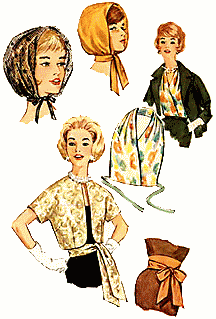
FASHION ERA 1950s

Women's fashions in the 1950s reflected a complex mix of conservatism and glamour—both girl-next-door freshness and alluring femininity. Women who had survived the Great Depression and World War II could now afford new styles and embraced them all, from the elegance of grand, sweeping skirts to shorts and trousers.
Hallmarks of 1950s Fashion
-
An hourglass figure predominated
-
Skirts were big with crinolines or slim pencil skirts
-
Women increasingly wore trousers


Popular Prints of the 1950s
-
After the austere colors of the 1940s, prints came back in a big way. From stripes to florals, prints generally appeared in colors on a white background.
-
Wild floral skirts, like the one above, contrasted with a plain-colored, short-sleeved knit top.
-
Stripes of all kinds appeared, from bold black-and-white horizontals to thin black or dark blue stripes on a light background, often worn with 3/4-length sleeves.
-
Polka dots showed up in contrasting colors, like red on white (and vice versa), or dark blue and white, or white on white with nubby or textured dots.
-
Embroidered designs and appliqués were often featured near the hem of a wide skirt. A felt poodle appliqué became the iconic symbol of '50s style and is often worn today for '50s parties or for Halloween.
Fabric Types
When nylon was no longer required for military parachutes, it was employed to create hose, lingerie, blouses, and sportswear, among other fashion essentials.
Although cotton remained a popular material for summer clothes. The new clothes that drip-dry made laundry tasks easier. Two-way stretch fabrics that provided figure control for swimsuits were included in the new fabric blends.
Synthetic fibres and blends reduce the market share of the wool industry while freeing the consumers of troublesome moths that might ruin wool clothing kept in the closet.
Women in the factories during World War II found a new level of comfort and freedom when they put on pants. Tight-fit slacks, short shorts, and roomy hostess pants—trousers have influenced women's fashion.
Because it left a smooth front and seemed dressier than front-zipped jeans, the side zipper was a popular closure.
Women in Pants



Gloves. A well-dressed woman wore gloves and a hat outside the home. Long, elbow-length gloves appeared for formal and evening wear with short-sleeved dresses or strapless gowns. Short gloves worked with suits and were also worn in warmer months.
Hats. The New Look debuted beneath broad-brimmed garden hats. But smaller hats prevailed for most of the 1950s. Tidy little hats adorned with veils were popular and came in an assortment of colors, often pastels for spring and summer.
Jewelry Jewelry was classic and understated. Pearls or faux pearls were the iconic necklaces of the 1950s. Slim watches and subdued rings, along with clip-on earrings, were conservative and elegant.
Shoes. High heels worn for dressy occasions had rounded toes, often with peep-toes. Espadrilles were a popular choice for beach and vacation wear. Saddle oxfords, a relic of the 1940s, were popular with the younger set, often paired with short socks called bobby socks.
Accessories of the 1950s



Hairstyles
For formal occasions, young girls' long hair was pulled up into ponytails or twisted into a French twist
The Italian hairstyle featured short, loose curls for a sophisticated yet free appearance.
Bangs were worn short and curled with both short and longer hairstyles.



Influential Fashion Designers of the 1950s
While Christian Dior gave birth to '50s fashion with his New Look in 1947, many other designers influenced the decade.
-
Clare McCardell,
-
Cristóbal Balenciaga
-
Hubert de Givenchy
-
Coco Chanel
Referencing
Fashion History: Women's Clothing of the 1950s
Website title:Bellatory
URL:https://bellatory.com/fashion-industry/Fashion-History-Womens-Clothing-of-the-1950s